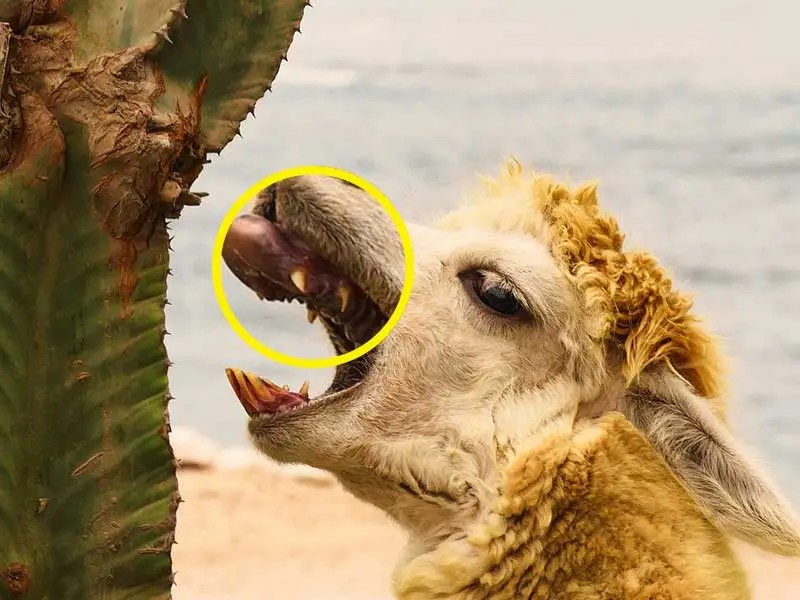Last night I watched a 2019 movie with Matt Damon and Christian Bale called ‘Ford v Ferrari’. In one of the scenes, the two of them get into a rather comical fight.
After tiring themselves out, they briefly discuss the fight. While laying on the ground, trying to catch a breath, Ken (C. Bale) asks Carroll (M. Damon): What was that grab… on my arm? And Matt Damon responds with: I call that the “Llama Bite.”
This made me wonder: do llamas bite?
In this article, we will explain exactly that. You will learn:
- If llamas bite other llamas
- If llamas are aggressive and bite humans
- What is the biting force of a llama
- And should you worry when approaching a llama

Table of Contents
Do Llamas Bite?
Llamas are temperate, confident, and intelligent creatures. Generally, llamas do not bite. They will occasionally get into fights with other llamas or humans where they might spit, kick, or bite them. Sometimes, llamas develop psychological conditions where they viciously attack and bite humans.
Because of their slightly more aggressive nature, llamas can be easily trained as guard animals. These guard llamas will protect livestock at night, attacking, biting, kicking, chasing away, and sometimes killing predators like foxes or coyotes.
Sometimes, llamas might gently bite other llamas as part of their play behavior.
Play is not clearly defined in llamas, but scientists think that it plays a role in the development of the locomotor and nervous systems. Camelid play can be divided into locomotor, sexual, and aggressive play.
Llamas that are being locomotory playful will jump, run short distances, quickly stop, turn, and flick their tails.
Llamas express their aggressive or attack play behaviors by spitting, biting, kicking, and neck wrestling. Mostly crias and young llamas will play and scuffle when they feel relaxed and secure.
Llamas are also very territorial animals that will do anything to protect their “harem” from usurping males.
Do Llamas Bite Other Llamas?
Male llamas do not like when other males come near their herd. They will get into fights, spit, kick, neck wrestle, or bite to chase the competition away. Males will even use their razor-sharp teeth to castrate other males.
Yes, you read it right!
By the time they become sexually mature, males develop six fighting teeth, two upper and one lower set. These sharp and dangerous canines can do a lot of damage to llamas and other animals.
Usually, there are three social groups in llamas: (1) the family group of an adult male and several females and their offspring, (2) the group of single males, and (3) solitary males or very old males that were rejected from other groups.
That adult alpha male from the first group does not like when other males approach his group. He will do everything to defend his territory against the intrusion of non-group members. Offensively, these males will scream, bite, charge, chest butt, rear up and strike down on another male.
When male llamas fight with other males, they bite the neck, throat, hind limbs, and scrotum.
They can be especially nasty to the genitals of their enemies. Mature males will use their long curved ‘fighting teeth’ to bite off the testicles of mating rivals! That’s one way of dealing with competition, I guess.
To protect themselves from such injuries, llamas developed several anatomical adaptations.
The skin on the neck region can be as much as 0.4 inches (1 cm) thick. Their jugular vein is nestled deep into the body of the neck. This prevents neck bites from punctuating the vein and resulting in bleeding out, and the death of the animal. The vein serves as the main source of blood flow down from the head. Also, llamas have thick skin over the scrotum, as additional protection for the testicles.
To prevent such injuries, llama owners will often take out or trim their teeth.
Do Llamas Bite Humans?
In most cases, a llama will not bite a human, not even in self-defense. Llamas are considered obedient animals that will only resort to biting you as a last resort if you provoke them hard enough. Sometimes, llamas might develop a psychological condition that makes them dangerously aggressive toward humans.
The main defense of a llama is spitting; in most cases, they will not sink their teeth into you. The chance of a llama getting to a point that it might bite you is very slim. And in most cases, it might mean you deserved it. If a llama lowers its ears, take that as a warning sign to back off.
If humans give too much attention to bottle-fed male llamas or neonates, the animals can develop a dangerous behavioral pattern called the Berserk Llama Syndrome (BLS).
In this situation, the crias are imprinting on their human handlers to such a degree that they consider them to be fellow llamas. And when they reach sexual maturity, llamas with BLS can’t distinguish humans from other llamas and will try to demonstrate their dominance.
A male youngster might approach and push its nose into a person’s face or gallop up and push the owner around with its neck or chest. It might bite its handler or sneak up and attack it from behind.
Several people have been severely injured by vicious attacks of otherwise handleable males.
Not all imprinted males develop aberrant behavior, and some may just become obnoxious but not dangerous.
If properly reared and trained, male llamas are as safe and as easy to handle by humans as female llamas.
Further reading: Berserk llama syndrome – causes, prevention, and treatment
Are Llamas Dangerous To Humans?
Because of their calm disposition and moderate size, llamas are very safe animals to work with. Llamas don’t bite and rarely kick. Occasionally, they might get into fights with other males, but they are generally safe for humans.

As well as feeling safe when leading the llama, you do not need to worry that your llama will run away. They have a strong herding instinct and prefer to stay grouped with other llamas.
You do want to beware of the llama with the berserk-male syndrome.
Interestingly enough, the early sign of berserk male llamas is over-friendliness. A llama that acts like a tail-wagging dog and runs across the field to breathe in your face might be berserk. Regular llamas mostly ignore attention from humans.
And just with any other large animal, you want to be aware and careful when handling a llama.
Llama’s Biting Teeth
Llamas have two fighting teeth or fangs on the upper and one on the lower jaw. These are modified canine and incisor teeth, they are very sharp, and can cause serious injuries.

Their biting teeth first appear between 2 and 3 years of age in males, and around 4 to 5 years in females. These deciduous canines are quite small, razor-sharp, and peg-shaped.
These teeth are part of the digestive system and are mostly used for food chewing. Read more about it here.
Llama Bite Force
Bite force can be defined as “the force exerted by the masticatory muscles upon the occlusal surfaces of teeth”. It is usually measured in PSI (pounds per square inch). It is a unit used to calculate the pressure made per square inch of each pound.
There is no exact data on the biting force a llama’s jaw can produce but we estimate it to be similar to the biting force of some ruminants: between 200 and 300 PSI (140-200 N).
As a comparison, humans produce a jaw force of around 200 PSI (137 N).
To process mechanically challenging foods, llamas need to have strong mandibles and produce adequate bite forces by recruiting their jaw muscles.
Llamas will eat almost anything; grass, leaves, even shrubs, and coniferous trees. Because of their three-chambered stomach, llamas can digest all that harsh and barely digestible food.
Summary
This concludes our article examining the topic of “do llamas bite?”.
Despite being well-mannered animals, llamas will occasionally bite. They will mostly bite other members of the herd to protect their harem; sometimes they might even bite humans. There is an aberrant behavior syndrome where bottle-fed llamas attack their owners. This is however rare and in many cases treatable.
When working around llamas you should always be alert and check for signs that a llama might attack you.
References
[1] Tynes, Valarie V., ed. Behavior of exotic pets. John Wiley & Sons, 2010.
[2] Fowler, Murray. Medicine and surgery of camelids. John Wiley & Sons, 2011.
[3] Nett, Emily M., et al. “Mechanical properties of food and masticatory behavior in llamas, Llama Glama.” Journal of Mammalogy 102.5 (2021): 1375-1389.